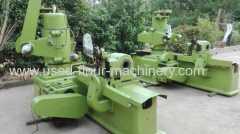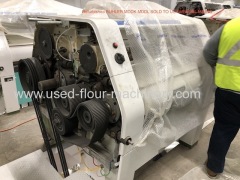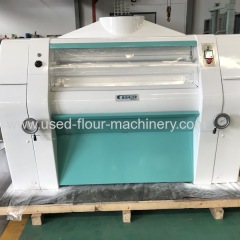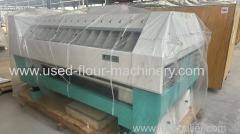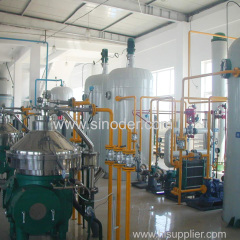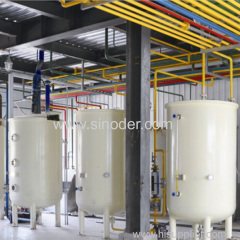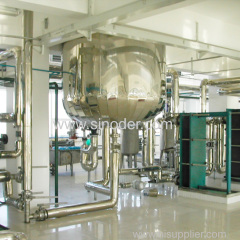|
Henan Yongle Group Oil Machinery Co.,ltd
|
Lecithin and Lecithin Powder Plant Rice Bran Lecithin Plant Soya Lecithin Plant
| Payment Terms: | T/T,L/C,D/A,D/P,WU,Paypal,Money Gram |
| Place of Origin: | Henan, China (Mainland) |
|
|
|
| Add to My Favorites | |
| HiSupplier Escrow |
Product Detail
Lecithin is a natural ingredient mainly derived from the soybean It contains a range of emulsifiers, stabilizers and release agents We are the leadin
The soybeans are conveyed in the plant, where screening and cracking to
appropriate dimensions are conducted. Beans, in the plant pass through
solid fractions developing a bow wave ahead of each blade. Our Lecithin
Plant requires can be easily easy cleaning and requires minimum
maintenance.
The
rice bran oil contains phosphotides, protein, carbohydrates mucilages
and resins as gummy substances which impart color turbidity and odor to
the oil. However, phosphotides are the major component of gum which
increases refining losses, create foaming problem and generate more
color.
The extracted rice bran oil was dewaxed than prepare to degumming. In
the process of degumming, some degumming agents are used for recovery of
oil and gums from the dewaxed rice bran oil.
Lecithin is a natural ingredient mainly derived from the soybean. It
contains a range of emulsifiers, stabilizers and release agents.
We are the leading company, manufacturing plants for dehydration of wet gums that are obtained from soybean oil degumming plant.
In the plant, a series of operations is carried out in order to get pure
quality of lecithin. The process involves bleaching, dehydration,
extraction, purification and drying. The lecithin produced is of food
grade and thus widely used in cosmetic industry, pharmaceuticals and in
food processing as emulsifier.
The soybeans are then conveyed into the plant in which, the beans are
screened and cracked to appropriate dimensions. All the cracked beans
are then passed through solid fractions, forming a bow wave ahead of
each blade. The lecithin plant needs less maintenance with easy
cleaning.
Features
1. Continuous operation
2. Low oil residue in extracted meal
3. High production flow rate
4. Less consumption of energy
5. Technology based solvent extraction process
Process Description for Soya Lecithin PC-35 & PC-10 Plant
Lecithins are present in edible oils as naturally occurring phospolipids with excellent surfactant and nutraceutical properties.
There is great demand for lecithin and its derivatives for various
applications. These are present in abundance in the gums of edible oils,
especially soya bean oil.
The edible oils, when refined, the first treatment step of degumming
using water is done in order to isolates the gums. Then, these gums are
completely removed from the oil in centrifuges and invariably carry oil
and water with the gums.
These gums, once considered as the waste products, today, are widely used in many applications.
Firstly, these gums are de- hydrated in a vacuum distillation system for
the removal of water, yielding liquid lecithin. The liquid lecithin,
which is basically a mixture of oil and lecithin, is distilled off under
high vacuum.
The crude soya liquid lecithin has also it wide usage in the production of various grades of Phosphotidyl Cholines.
In this process, firstly, the liquid lecithin is extracted with the
addition of ethyl alcohol. After extraction two layers are formed, in
which one layer is rich in PC-35 and the other is rich in PC-10.
The two layers are then decanted into two separate vessels, in which,
each layer is subjected to ethanol recovery. After the recovery of
ethanol, the final product that is left is PC-35 and PC-10 respectively,
each of which is a salable product. The recovered ethanol is fed into
the extractor for recycling.
The entire extraction process carries no chemical reactions, with no
molecules of any constituent undergoing any kind of chemical change.
There is no generation of any effluent, be it aqueous or air borne. The
only aqueous effluents that are generated are floor washes that can be
easily trapped off and then directly used for gardening.
One ton of Liquid lecithin gives about 200 kg of PC-35 and 800 kg of PC-10.
Process Description for Soya Wet Gums Lecithin Plant
Wet gums generated from water de-gumming plant are continuously
collected in the inter gum tank, which is constructed out of mild steel.
For proper homogenization of the wet gums, these are conveyed to a
habituation tank through a positive displacement pump. Finally, these
wet gums are then fed to a high speed mixer.
Wiped type evaporator is specially designed with scrapped blades in
order to keep the gums scrapped from the heat transfer surface.
A low pressure steam is injected in the jacket for heating the entire
mass. All the vapors formed are continuously collected in the separator
from which, these water vapors are separated from mass. In addition to
this, the separator is attached with a limpet coil that keeps the dried
gums in a fluid state.
An accurate amount of H2O2 is fed with a high speed mixer to the dryer.
The key equipments like vapor separator and wiped type thin film
evaporator are maintained under vacuum for effective processing.
There is a pre-condenser and a water ring vacuum pump in the vacuum
system. The dried gums which is now formed into crude lecithin is fed to
a wiped type cooler through a positive displacement pump for cooling at
around 50 - 60 degree Celsius.
In order to protect the process from oxidation, the complete system is
hermetically sealed at a process temperature. The dried crude lecithin
can be further processed as per the requirements.
Process Description for Lecithin De-oiling & Powder Plant
Prior to the extraction process, the crude lecithin is pretreated in
order to lower down the peroxide number and microbial count. This helps
in improving the subsequent extraction process.
The entire extraction process of crude lecithin is carried out using
a-cetone solvent. After pre- treatment, the lecithin gets extracted in
two stages with precipitation of a-cetone insoluble i.e. lecithin.
In the process, a unique designed extractor is installed that ensure a
rapid and efficient extraction. The miscella, after extraction is
withdrawn into a miscella tank and then the thick solid slurry is
transferred to a decanter feed tank.
The a-cetone is recovered from the miscella in the a-cetone recovery
system for further reuse. The soya oil left out after a-cetone recovery
is saleable.
In the decanter feed tank, the thick solid slurry is decanted in a high
speed centrifuge, filtering out the a-cetone and the solids.
The separated solids are carried for drying and on the other side; the
separated a-cetone goes to the miscella tank. There is installed a two
staged closed loop continuous fluidized bed dryer, in which a-cetone wet
solids are dried. A PLC controlled system, the drier is specially
designed with a nitrogen generator.
The other requirements in dryer are thermic fluid maintained at 120
degree C and chilled brine at -30 degree C. The deoiled lecithin powder
generated from the drying system is micronised, sieved and packed.
After extraction, the miscella generated undergoes through a four stage
a-cetone recovery system in which there is only a little loss of the a-cetone. The a-cetone recovered from the plant is then condensed and
further recycled for extraction process. The residue soya oil that is
left out can be sold off.




